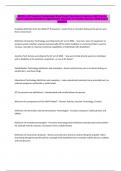RESNA ATP Assistive Technologies Book Exam | Questions & Answers (100 %Score)
Latest Updated 2024/2025 Comprehensive Questions A+ Graded Answers | With Expert
Solutions
Disability definition from the WHO ICF framework - results from a mismatch between the person and
their environment
Definition of Assistive Technology according to the AT act of 2004 - "any item, piece of equipment or
product system whether acquired commercially off the shelf, modified, or customized that is used to
increase, maintain or improve functional capabilities of individuals with disabilities"
Assistive Tech Service according to the AT act of 2004 - "any service that directly assists an individual
with a disability in the selection, acquisition, or use of AT device"
Rehabilitation Technology (definition and examples) - devices with primary use in a clinical setting, ex.
parallel bars, overhead slings
Educational Technology (definition and examples) - make educational materials more accessible such as
software programs and braille or audio books
AT for personal use (definition) - individualized and usually follows the person
What are the components of the HAAT Model? - Human, Activity, Assistive Technology, Context
Definition of Information and Communication Technologies - Includes computers mobile phones and
tablets
Definition of everyday technologies - Pervasive technology that facillitates everyday tasks and activities
for example remote controls, microwave ovens, mobile phones
Definition of mainstream products - Devices and seervices that are used by the general public rather
than being dessigned speciificcally forr peopple with disabilitiies foorr example mobiile phones, taablets
and ccompuuters
,What is the everyday technology use questionnaire (ETUQ) - Clinical tool that assesses the perceived
relevance of, and difficulty in use of, everyday technology.Includes both ICT's as well as common
household technologies such as an iron, stove, radio, microwave, and televisions and DVD players.
Technologies outside the home such as elevators, code operated door locks, ATMs, and automated
flight check-in are also included.
Examples of mainstream technologies that were originally developed for people with disabilities -
Cassette tapes, audiobooks, typewriter, ballpoint pen, carpenters miter blocks, telephone, texting,
Closed captioning, voice recognition, on-screen keyboards, speechh synthesis and digitized speech,
mouse keys, sticky keys, word prediction, toggle switches, customizable color schemes, screen
enlargement, head tracking devices, single switch hardware interfaces example PowerPoint remote,
swype text input for touchscreens
Definition of universal design - The design of products and environments to be usable by all people, to
the greatest extent possible, without the need for adaptation or specialized design
Benefits of universal design - Less expensive than modifying a product after production
Examples of universal design - Sidewalk curb cuts, automatic doors, low buttons on elevators, audible
crosswalk signals, elevators, large bathroom stalls
Seven principles of universal design - 1. equitable use:T he design is useful and marketable to people
with diverse abilities. 2. Flexibility in use: the design accommodates a wide range of individual
preferences and abilities. 3. Simple and intuitive use: use of the design is easy to understand regardless
of the user's experience, knowledge, language skills, or current concentration level. 4. Perceptible
information: the design communicates necessary information effectively to the user regardless of
ambient conditions or the user's sensory abilities. 5 tolerance for error: The design minimizes hazards
and the adverse consequences of accidental or unintended actions. 6. Low physical effort: the design
can be used efficiently and comfortably and with a minimum of fatigue. 7. Size and space for approach
and use: approximate size and space is provided for approach call, reach, manipulation, and use
regardless of user's body size, posture, or mobility
Cons of universal design - Universal design does not completely eliminate the need for specially
designed assistive technologies because the variety and complexity of individual needs are too great for
inclusion in a single product
, Definition of modular system - Combines mainstream and specially designed technologies, assemble
NAT system as a set of distinct components that can be developed independently and then plugged
together, modular based solutions can provide the individual with optimum usability as the solutions
can be adapted exactly to the needs and requirements of the individual
Definition of commercially available - Devices that are mass-produced and available off-the-shelf both
for the general population and for individuals with disabilities. Everyday technologies are included in this
category
Examples of universal design in automobiles - Blind spot warning system - useful for individuals with
limited peripheral vision or those who have difficulty turning their head to check for hazards
What are the international standards for web accessibility - World Wide Web Consortium Web
accessibility initiative W3C WAI, Web content accessibility guidelines WCAG
What are mobile technologies - Phones and tablets
What is a key guard - Placed over a standard keyboard isolates each key and helps the person target the
desired key
Example of automobile adaptations - Hand controls replace the pedals for people with lower extremity
weakness or paralysis
What are electronic aids for daily living EADLs- Definition and example - Remote controls
Common mainstream technologies used for job accommodation - Letter folding machines, electric
staplers, adaptive keyboards, telephones, headsets, material lifts, ergonomically designed tools and
chairs, anti-fatigue mats
Definition and example of hard technologies - Readily available components that can be purchased and
assembled into AT systems. This includes everything from simple mouth sticks to computers and
software




